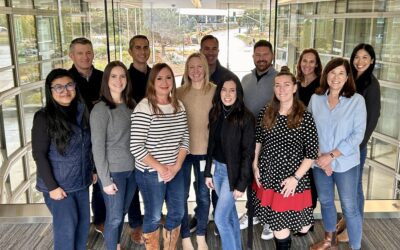There has been an influx of surveys conducted to explore this notion of ‘a sense of belonging’ that employees experience within their organizations and, importantly, what contributes to the feeling and desire to remain with their employers. The 2022 Workplace Belonging Survey conducted by Ipsos uncovered the following:
- Two in three say a sense of belonging at work means having their perspectives and/or contributions valued by their colleagues and superiors (64%) and working in an environment where they feel accepted (64%).
- The largest disparity between what workers think belonging means and what they currently feel at work is “being treated fairly and respectfully at work” (17 percentage point difference), followed by “having their perspective and/or contributions valued by their colleagues and superiors” and “feeling connected with others at work” (15 percentage point difference for both).
Organizations can drive belonging by actively examining and addressing biases, creating spaces for deep understanding, focusing on building community and integrating systemic practices into their ways of working to achieve DE&I goals. By prioritizing well-being and accessibility, leaders can create an environment where everyone feels included and supported. This can reduce employee burnout, increase engagement and productivity, and, most importantly, foster a sense of belonging.
Although a subjective experience, belonging depends on individual experiences and perceptions. Leaders directly impact an employee’s day-to-day work experience, including their ability to thrive in the role. Studies show that people often quit their jobs due to their manager; therefore, the practices highlighted in this article will focus on the leader’s role in integrating wellness and DE&I within the flow of work. Across these practices, you will notice two recurring themes: listening to employees and recognizing employees.
Honoring the diversity of your team
We are all extraordinarily unique individuals with lived experiences, beliefs, values, and social identities that frame how we are motivated, think, feel, and act. What can be learned from employees beyond their skills and years of experience that can challenge thinking? Lived experiences should not be discounted, as the experiences and lenses people wear can be just as valuable as advanced education, years of experience, and credentials.
- Consider utilizing assessments to allow individuals to learn about themselves and others through a common language and understanding of individual differences. Clifton Strengths and Personality Styles at Work focus on identifying an individual’s unique strengths, while Hermann Brain Dominance and DiSC focus on categorizing individuals’ behavioral tendencies and preferences. Leaders should use this information to deliberately assign tasks and responsibilities that play to strengths to create a more balanced and effective team.
- Offer reverse mentoring to pair younger professionals with senior executives so they can share knowledge and skills related to social media, technology, and other emerging perspectives. Younger professionals can feel heard and valued while bridging the generational gap to promote understanding, respect, and trust across age groups. With guidance, this approach can challenge senior executives’ thinking.
- For the next job posting or team assignment, challenge the ‘years of experience’ requirement by considering what exposure and lived experiences may be relevant.
Deliberate recognition
Workhuman and Gallup’s recent report From Appreciation to Equity: Recognition Reinforces DE&I In the Workplace discovered that recognition is one of the most effective and affordable ways to improve well-being and advance DE&I outcomes. Research shows that receiving various forms of recognition supports employees’ sense of belonging while also contributing to key measures of financial success—including increased productivity, decreased safety incidents, and lower absenteeism.
- Consider what gratitude or positives have gone unsaid about an employee’s performance. Narrowly recognizing high performers excludes employees still adding value (i.e., performing their duties).
- Examine which employees receive recognition regularly due to their high visibility, then challenge yourself to seek out ways to recognize less visible yet impactful contributors. (Congratulations, you are confronting bias!)
- Identify moments that matter to employees within the flow of work so that you can observe and provide recognition specific to their focus areas (such as stretch assignments or new challenges)
Collective decision-making to improve physical well-being
People often associate “physical well-being” with working out and eating right. Going beyond these associations, consider what new agreements can be created with the team to have a more balanced and accessible workflow, whether in person or remotely.
- Encourage connections in nature (i.e., outdoor walks during breaks or 1:1 meetings).
- Be intentional about how extended team meetings are structured, such as half-day planning or multi-day co-working sessions. Include time for breaks for people to move about the space and recharge on their own.
- Encourage employees to block off their calendar for daily “no meeting” times and honor them. Model good working boundaries for employees by honoring their calendar status.
- Recognize employees when you see them caring for themselves.
“The research shows that employee engagement hinges on employee well-being. There is no-one-size-fits-all button to push regarding well-being. The subjective nature of well-being (unique to every individual) will push organizations to listen with compassion and act with intention as they develop policies and programs to meet the unique composition of needs within their workforces. Just as all individuals experience the ebbs and flows of life, organizations must maintain an open and ongoing feedback loop to understand how best to serve their employees’ fluctuating well-being needs.”- Dr. Kibibi Springs, I-O Psychology Practitioner, Researcher & Practitioner in Rest, Recovery Cycles & Employee Wellbeing
Examine and correct power imbalances
A sense of belonging makes team members comfortable enough to provide feedback, share ideas, and confront tension. Leaders can work toward creating a culture where power is shared among team members who openly address power struggles through transparent communication.
- Ensure there are opportunities for everyone to participate in meetings, decision-making processes, and career progression opportunities. One method won’t work for all work styles, so provide a variety of ways for employees to participate and engage.
- Explore how you consider the voices of early-career employees. Often their voices are disregarded unconsciously due to lack of experience or age. Similar discrimination happens to people of color, women, and English as Second Language speakers.
- Create spaces allowing individuals to share stories about their experiences to connect and understand.
Care for social well-being through relationships
One way to prioritize the creation of safe environments within the workplace is through your relationships. By prioritizing social well-being, leaders can foster a culture of inclusivity and support through community—as well as positively impact mental health through connection.
- Be explicit that it’s OK to have fun at work. (AKA know who’s the in-house DJ on the team!)
- Establish a collective agreement on social time for the team to connect outside work projects or meetings, such as Connection on Thursdays from 12-2pm. Be clear on the purpose of this time and honor the commitment; model what you want to see, and the team will follow your lead.
- Connect with Employee Resource Group leaders to hear the needs and wants of marginalized identities; then, explore findings with your team to identify changes to current ways of working.
- Encourage teams to solicit different perspectives to get curious and practice lifelong learning (and unlearning); create space for them to connect with experts, ERG speakers, local non-profits, and vendors.
Storytelling within safe spaces
As a leader, your team expects you to understand what is happening at work. By creating a safe and brave space for open dialogue to humanize individual experiences, leaders can foster greater empathy and understanding among team members. Doing this requires leaders to model bravery, curiosity, compassion, and to actively listen to employees.
- Discuss with your team what you are learning and unlearning, then uncover their perspective too.
- Talk about mental health and challenges (such as burnout for caregivers, social anxiety, stress). Starting the conversation can help employees feel less alone or anxious. Talk about mental health even when there isn’t a crisis.
- Foster open dialogue among team members about what they like and don’t like about their position as it aligns with their strengths. (Bonus points for this practice also supporting their career wellbeing.)
By creating a sense of belonging within organizations through recognizing diversity and prioritizing employee well-being, leaders can foster a positive work environment that promotes inclusivity and increases engagement and productivity while breathing equity into the system and creating accessible environments for all to thrive.
For further reading, check out A Strengths-based Approach to Building an Equitable Workforce.




